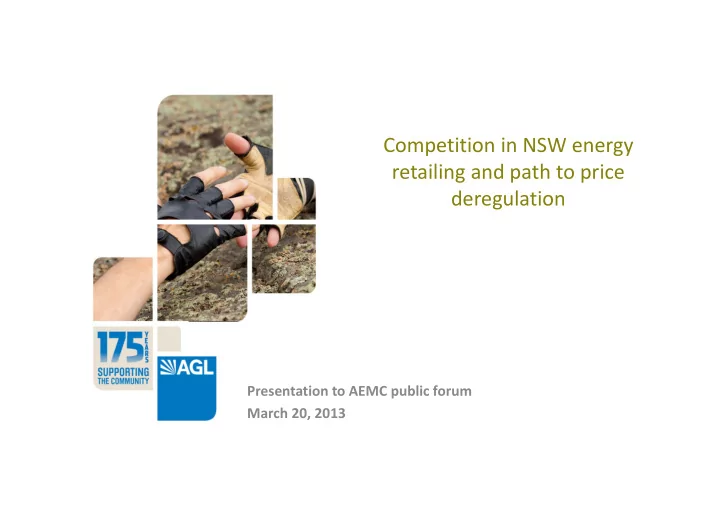

Competition in NSW energy retailing and path to price deregulation Presentation to AEMC public forum March 20, 2013
Indicators of competition Strong rivalry between competitors for sale of electricity/gas. • Product differentiation – with scope for significant development with price • deregulation. My AGL IQ ‐ free national online energy monitoring tool that will help AGL customers to track & reduce their energy usage
Indicators of competition High customer switching rates – around 19% for electricity and 14% for gas. • Compare this to other industries: insurance (12%), health (4%). – Good customer awareness of ability to change retailers and many sources of • information on availability of competing products. Barriers to entry, expansion and exit do not preclude entry/exit from market • => effective competition for retailing gas and electricity in New South Wales. Biggest threat is unnecessary regulatory intrusion on retailers’ pricing decisions in a well functioning market.
Numerous benefits would flow from retail price deregulation Meaningful product differentiation (involving more than just discounting) between • retailers, and within individual retailers’ product offerings, such as different shaped tariffs to suit different consumption profiles. Time of use tariffs – Dynamic critical peak pricing – Tariffs tailored for high/low consumption profiles – different combinations of high/low – fixed supply charges and higher/lower variable energy charges. Energy conservation tariffs – rebates provided consumption remains below certain kWh – level on certain days.
Transition to deregulation Immediate transition for all customers at the same time (South Australian model). • Would lead to healthy level of market stability and certainty. – Would ensure that the full benefits of competition, and tariff and product innovation, – would be able to be utilised by all customers from the outset. Needs to be accompanied by consumer education campaign. • IPART to adopt price monitoring role. •
Recommend
More recommend